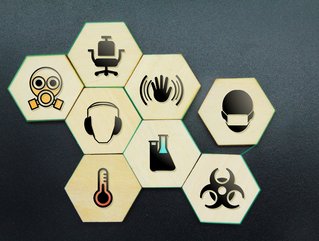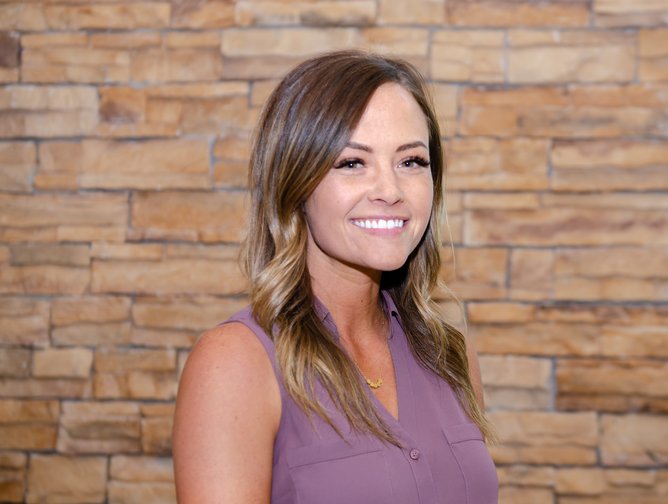5 minutes with Jade Brainard, Product Director for KPA

Jade Brainard is the Product Director for KPA, an EHS (Environment, Health and Safety) solutions company, which makes it easier for businesses to keep their workers safe and stay in compliance with local, state and federal statutes. It does this in two ways: onsite consultation and software.
On the consultation side, KPA has a 300-person team of EHS experts who work with businesses in manufacturing, automotive, construction and the oil and gas industry to make their workplaces as safe and compliant as possible. KPA offers one-time audits, as well as ongoing consultation services to support a wide range of EHS needs.
On the software side, KPA’s products are mobile-first and deliver educational and training content via interactive, highly customised micro-lessons. The high-level effect is that EHS training becomes part of daily life, which increases the likelihood that workers internalise and normalise safe behaviours.
“I’ve been with KPA for over 15 years, overseeing product direction, which essentially means I’m always thinking about what we’ll build next,” said Brainard.

Jade Brainard, Product Director for KPA
How has workplace safety changed since COVID-19?
“The most immediately visible change was the introduction of new rules and regulations: PPE and time off requirements, vaccine mandates, safety protocol for days with high absentee rates, and so on. Those were changes to safety rules. But the more profound change was to the way companies engage with safety training overall.
“Suddenly, certain methods for delivering educational content – like in-person group trainings – were no longer advisable. Even communal, paper-based safety sheets could put workers at higher risk by forcing them to be in shared spaces and touch shared surfaces when they might not have otherwise had to.
“Pen-and-paper safety programmes were becoming less popular pre-pandemic, but COVID-19 accelerated that significantly. All of a sudden, there were all these new benefits to delivering EHS training digitally: not only was it more convenient and easier for employees to get custom content, it also provided employers a way to continue safety training without exposing workers to unnecessary risks (including, of course, the virus).
“Workplaces that embraced digital EHS software at the start of the pandemic saw that decision validated again and again as guidelines and protocols have changed over the years of the pandemic: it’s infinitely easier to update a digital platform than an analog, paper-based system. For example: when PPE requirements were introduced or changed, KPA users could add or update proper-use modules to their content libraries, then push notifications to all employees to review these modules.
“When vaccines rolled out, companies could update workplace requirements digitally, easily adding a place to capture proof of vaccination and creating messages and reminders to encourage compliance.
“Of course, while all these tools were essential during the height of the pandemic, they’re also valuable to businesses at any time it’s necessary to adapt to new information or regulations, add new content to accommodate new risks, or expand training for a new type of work – which is to say, all the time.”
Tell us about the dangers of operating machinery.
“Operating machinery can be dangerous, especially without proper guarding in place. OSHA notes that there are about 18,000 injuries and more than 800 deaths each year among machine operators and maintenance workers.
“The human cost is considerable. Even in a best-case scenario where there are no major injuries, a near miss can hurt morale and productivity and even lead to attrition if an employer doesn’t address the issue. Then there are the financial costs: a single violation comes with a penalty of more than US$15,000.
“But it’s not necessarily machines themselves that are the primary source of danger. More often, it’s workers operating machinery in unsafe ways. In most cases, this behaviour isn’t intentionally unsafe – it often happens because of oversights and gaps in an organisation’s safety programme.
“For a manufacturing business to run smoothly, employees need to be trained to operate highly specialised machines, managers need to ensure work is being done correctly and on time, and leadership needs to allocate limited resources effectively.
“A digital safety programme makes all of these possible. Mobile-first EHS software lets employees access vital information at any time, from anywhere. Software like KPA’s also delivers information in manageable chunks, offers interactive lessons and provides opportunities for repetition – all important for improving learner retention.”
How can a good safety programme help train, educate and prepare employees to keep them safe?
“The goal of a good safety programme is to create a culture where safety is second nature – like looking both ways before you cross the street. The reason people are so good about looking both ways is because we understand the mechanics of what happens at crosswalks and what behaviours are necessary to keep ourselves safe.
“Achieving that level of understanding for a variety of complex machines is, of course, hard. It requires educating employees not just about what to do to be safe but also about where the risks come from and why certain behaviours help protect them. It requires making safety and safety education part of the daily company culture.
“That’s one reason mobile solutions can be such an impactful tool. Software like ours makes it possible for every employee to get the safety training they need in a way that’s convenient. That might mean requiring employees to complete certain refresher modules at regular intervals. It might mean serving different lessons to employees with different levels of experience. It might mean offering the same information to employees in different languages to ensure comprehension is at 100% before work begins.
“In other words, good EHS software helps reinforce key information when it’s most relevant to workers. Combined with regular toolbox talks, bigger-picture certifications, and workplace norms that reward safety at every level, digital EHS solutions help businesses save lives, prevent injury, and manage costs.”
What are the best practices for a safety programme in the manufacturing industry?
“Great question. While every organisation’s programme will look a little different, these principles can help any manufacturing company increase safety, boost morale, increase productivity, and protect the bottom line:
Use multiple formats
“The most effective compliance training incorporates different media and approaches. This could be presentations, videos, interactive exercises, group discussions, self-paced assessments and more. It’s also beneficial for employees to have access to these mediums both online and on job sites.
Make sure you’re covering everything you need to cover
“Compliance training and safety programmes need to provide information about certain topics, as required by OSHA, the EPA and other regulatory authorities. Most worksites also have specific requirements. Knowing exactly what your employees need to know and providing all the information they need is essential to creating a safe workplace.
Tailor your content to your audience
“It’s important to know how your workers learn: what kind of lessons they’re most responsive to, what language(s) they speak, what style resonates most with them, and so on. You should also adapt your training to people of different experience levels; every worker needs to be trained, but not everyone needs to be introduced to a topic as though they’re not familiar with it.
Make it relevant
“Stories and real-world examples are more effective than dry, purely informational presentations. Wherever possible, embed your training in a detailed narrative that reflects your workers’ real experiences.
Use strategic repetition to reinforce key concepts
“Effective training communicates the same key points more than once – but it doesn’t simply repeat itself. Instead, it reinforces lessons in new contexts, creating connections in learners’ brains as they practise and digest the material.
“Put differently: Employers should aim to see a situation from a worker’s perspective, accommodate the various steps and decisions involved and have the patience to train, train, and train some more.”
Can you share your tips to get employees to listen and practice safety?
“Safe practices are most effective when they exist as part of an organisation’s culture. A culture of safety is always going to be stronger than even the best individual safety practices. When safety is part of an organisation’s culture, it becomes a driving factor in decision making. Rather than relying on individuals to “do the right thing” or advocate for safe practices, the organisation as a whole is aligned toward behaviours that promote safety.
“This may sound obvious. But problems tend to creep in when safety is seen as being at odds with productivity or when safety is seen as an add-on element to the ‘real’ work that employees have to do. To be clear, these attitudes are often not malicious or actively anti-safety. They might manifest, for example, as a manager calling for extra help from whoever’s nearby, regardless of their training or background.
“In a productivity-first organisation, workers understand that the priority is getting work done, so they may hurry over to help. In a safety-first organisation, the manager would slow down and ensure that workers have received adequate training for the tasks they’re being asked to help with. They appreciate the reality that a single safety mistake can cost far more than the few minutes it might take to review safe operation practices.
“So the question becomes, how do you build a culture of safety? Again, that’s no easy task. But a few strategies that can help include…
- Make safety the default mode. Training, education, and conversation about safety should be part of daily work.
- Invest in the infrastructure of safety. That includes proper PPE and safety equipment, adequate rest and hydration breaks and educational and training resources to make it easy for workers to operate safely.
- Reward safety-first behaviour. Praise the manager who chooses the safe route over the quick, less-safe win. Reward teams whose certifications are up to date. Tie bonuses to accident-free streaks.
What are your plans for the next 12 months?
“We are always looking for ways to solve our clients' pain points and keep our customers as safe as possible, so we are continually testing and updating our EHS software and thinking about how it can improve.
“We also have some exciting news on the horizon that will accelerate our efforts to make safety and training a top priority in as many work environments as possible. Contractor Management is one planned enhancement that will enable our customers’ safety and training practices to reach even further. Customers can ensure that not only employees have access to the tools they need to perform duties safely, but also all vendors, suppliers, and contractors that may visit customer locations.”
*********************************************
For more insights into Manufacturing - check out the latest edition of Manufacturing Magazine and be sure to follow us on LinkedIn & Twitter.
Other magazines that may be of interest - Healthcare Digital.
*********************************************
BizClik is a global provider of B2B digital media platforms that cover 'Executive Communities' for CEO's, CFO's, CMO's, Sustainability Leaders, Procurement & Supply Chain Leaders, Technology & AI Leaders, Cyber Leaders, FinTech & InsurTech Leaders as well as covering industries such as Manufacturing, Mining, Energy, EV, Construction, Healthcare + Food & Drink.
BizClik, based in London, Dubai & New York offers services such as Content Creation, Advertising & Sponsorship Solutions, Webinars & Events.
- SAP’s AI Joule set to Transform Supply Chain ManufacturingAI & Automation
- Top Ten: Diverse Companies in ManufacturingProduction & Operations
- How Smart Factories are Reshaping the Manufacturing SectorSmart Manufacturing
- Crowe UK: 2024 Manufacturing Outlook Report Explores GrowthProduction & Operations






